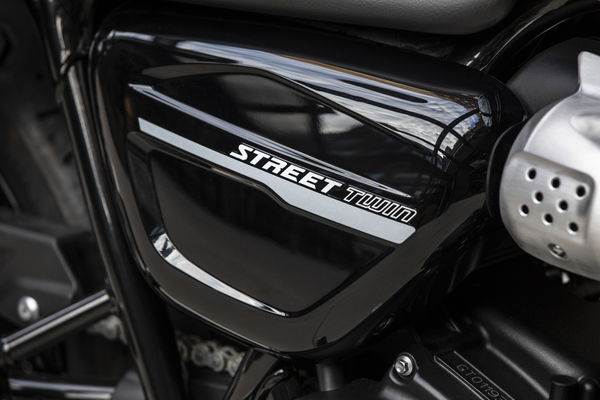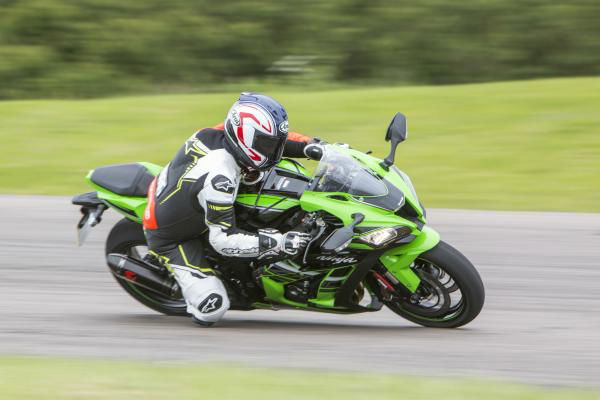Street Twin 2019 review
A perkier engine, uprated spec and first-in-class technology makes the Triumph Street Twin 2019 a modern classic worth owning

The Triumph Street Twin 2019 boasts excellent performance improvements which complement the classic looks.
Triumph Street Twin 2019: Design
As the daughter of a British bikeophile, I grew up surrounded by classic Triumph Bonnevilles, Nortons and mismatched combinations of both.
And one overwhelming memory is just how much they leaked. Rolling or parked, no gasket was enough to stop the slow seep. To this day these bikes still take pride of place in my old man’s living room, chrome polished and obligatory drip tray concealed underneath.
But British bikes have different connotations nowadays - that of reliability, high quality components and a far, far younger crowd.
And the Street Twin is a prime example. Launched in 2016, it didn’t take long for it to take the crown as the UK’s most loved Triumph modern classic. To date, the bike has sold more than 1,900 units – twice as many as any other in that range (in that timescale).
It’s stylish, fun and extremely accessible – with a seat height of just 760mm, even short riders can comfortable get both feet flat on the ground.
And Triumph herald the bike for its adaptability – claiming it is the perfect base for customisation. In fact, they’re rather proud of the fact that 80 per cent of bikes are sold with accessories on them – although it helps to bear in mind that the manufacturer often includes accessory vouchers with bike sales…

I’ve never really been one for modern classics, but I have to admit that the Street Twin is one very good looking bike. It’s not over-chromed, nor deliberately classic looking. In fact, it’s subtle, smart and as stylish as any of the manufacturer’s naked models.
A cool new logo stands out on the side panels, the speedo gets an updated clock with a new brushed ‘Bonneville’ badge, and new cast aluminium, multi-spoke wheels with machined detailing also catch the eye.

It will be available in colour options of Matt Ironstone, Korosi Red and Jet Black, with two optional ‘inspiration kits’ – ‘Urban Ride’ and ‘Café Custom’.
Triumph Street Twin 2019: Engine
The Triumph Street Twin features the same Bonneville 900HT (High Torque) liquid-cooled parallel twin engine as in its previous guise, with the same 270-degree firing order, and exactly the same displacement as the outgoing model.
However, it has received a host of uprated lightweight internals, designed to allow the engine to spin up faster and deliver higher power and performance. These components comprise a new magnesium cam cover, lightweight crankshaft, dead shafts and balance shafts, a mass optimised clutch cover and a lighter clutch. High service intervals, at 10,000 miles, promise to keep the cost of ownership low.
This engine is matched to a five-speed gearbox with ratios perfect for the urban commute. Clicking it into gear is met with a reassuring clunk, and the action is smooth and snag-free.
The EU will receive an A2 compliant version of the Street Twin, which restricts the power via an APS twist grip and engine detune.
And of course, it wouldn’t be a Triumph without that signature British twin rumble that escapes from the upswept exhausts (which cleverly hides the catalytic converter).

Thanks to this engine update, the Street Twin makes 18% more peak power – that’s about 9hp, giving it a peak of 64hp – with a 500rpm higher-revving redline, taking it up to 7,500rpm. This additional power is tangible, and combined with a nominal weight loss, the Street Twin feels perky, offering an engaging ride.
Torque, meanwhile, remains at a not-insubstantial 80Nm (59lb-ft), which peaks at 3,800rpm. However, while torque remains the same, there is more after the peak than on the previous model – all the way to an extra 10Nm at 6,500rpm.
A compromise comes in the form of a slightly later kick in lower down – torque commences 250rpm later than the previous model, and remains lower as it builds up to peak. But this is hardly noticeable, as there is ample in the most important range – from 3,500rpm to 5,500rpm, and cruising at 30 to 50mph in third to fourth gear is a great place to be. There’s much more grunt as you climb higher up the rev range, leaving suggestions of breathlessness a thing of the past.
Thanks to a ride-by-wire throttle and refined fuelling, power delivery is wonderfully smooth from the off, while a torque-assist clutch lightens the lever significantly.
For 2019, the Street Twin receives two riding modes of Rain and Road, which alter the throttle map and traction control accordingly. However, power delivery is so gentle in standard road mode that it offers no danger on wet tarmac.
Triumph Street Twin 2019: Suspension and Handling
While the chassis remains otherwise unchanged, the introduction of KYB 41mm cartridge front forks brings a new degree of ride refinement, absorbing the impacts of the jagged, bitumen-covered craters that criss-crossed Portugal’s mountain roads, and remaining unfalteringly straight and stable.
The rear KYB twin shocks are equally capable, swallowing hard jolts on a couple of occasions.
Pirelli Phantom tyres on the 18-inch front and 17-inch rear offered brilliant grip on our Portugal press ride, even when the glassy roads were slick from heavy rain overnight.
Triumph Street Twin 2019: Brakes
The uprated hardware continues with the addition of Brembo 4 pot caliper up front, gripping a 310mm disc. A Nissin 2-pot floating calliper features at the rear, on a 255mm disc.
This Brembo unit offers a great initial bite, and wonderful progression thereafter, and alongside the switchable traction control and ABS, bring the model in line with more conventional commuter options.
Triumph claim the Street Twin is many riders’ only bike, rather than others which complement a collection, and as such it requires a high level of spec to be able to compete with regular rides, and also deal with British roads and weather all year round.
Comfort:
At 5ft7 and a regular adventure rider, I’m used to balancing top heavy bikes on my tip toes.
The Street Twin was an at first strange, but welcome change. Despite Triumph having raised the seat height by 10mm over the previous version, it is still incredible low and accessible.
And that raised seat height offers not only a more spacious and comfortable riding position, but also a comfier bum, thanks to the extra padded foam which entirely makes up the height raise.
One slight thing I noticed after riding the Street Scrambler, was that I found the Twin’s bars to be slightly too low for my comfort. However, had I not ridden the Scrambler back-to-back with it, this would hardly have been a noticeable issue.
Triumph Street Scrambler 2019: Equipment
Again, bringing the Street Twin in line with conventional commuters is a host of useful, first in class tech. As standard, the model features an LED rear light, USB charging socket under the seat, and – perhaps most pertinently – an immobiliser, with a transponder incorporated into the key. And, of course, there are more than 140 optional accessories, including useful things such as a Tyre Pressure Monitoring System (TPMS).

When it goes on sale in January, the Street Twin will cost from £8,100 in jet black, with an additional £150 for either the Korosi Red or Matt Ironstone options. This is just a £300 price hike over the previous version, which is easily justified by all the extra spec.











